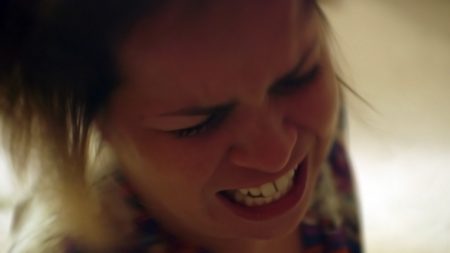 Back to selection
Back to selection
How I Shot My Feature Film, Tormenting the Hen, in Six Days
 Josephine Decker in Tormenting the Hen
Josephine Decker in Tormenting the Hen Filmmaker Theodore Collatos appeared recently on the site when he and Christopher Jason Bell interviewed each other about their latest pictures. He’s now at work on a new feature, Tormenting the Hen, produced with Matt Grady from Factory 25, Ben Umstead (Slamdance programmer, Screen Anarchy) and George Manatos (editor on Come Down Molly). He’s also in the midst of an Indiegogo campaign to support its co-production. Below, he reveals how — and why — he shot his new movie in six days (and how you might be able to do the same). Read on, and please consider supporting his campaign.
Tormenting the Hen is my follow up to Dipso (available on Fandor) and stars Carolina Monnerat, Dameka Hayes, Josephine Decker, Matt Shaw, Brian H. Brooks and David Malinsky. It’s a paranoid film inspired by an experience I had in rural Massachusetts and the early chamber dramas of Polanski, Weir and Bergman.
I shot the film in six days.
And, I know what you’re thinking already, this sounds absolutely batshit crazy. Six days? You’re already having images of grainy black-and-white Roger Corman productions and all the baggage that comes with that. But when you have a job and your cast has jobs and taking time off is asking a lot of them (and of yourself), you have to make it happen fast and make it count.
To give perspective to filmmakers starting out, or non-filmmakers, a typical shoot for an independent feature film can be anywhere from 12 to 30 days. Studio film productions can span months, with weeks for reshoots often scheduled from the outset.
And by all means, you’re right, you shouldn’t shoot a film in six days, but if you wanna go take the punk rock route, then here are a few tips on how to get it done professionally…
1. Work with People Who Care
I can’t overemphasize this first point. You can’t get great performances from people who don’t care. And performances are your collateral on a low-budget film. A pretty shot with bad acting is painful to watch. Much more painful then great acting and a crappy shot. People must care about you, your work, your script and you must care about them. If you give them a story, make them look and feel good, feed them well and the results will speak for themselves. Here are some examples….
Indie film stalwart Josephine Decker traveled two and half hours by train to rural Massachusetts and immediately upon arrival changed wardrobe in the parking lot, jumped into a car and shot a scene while driving an hour back to the film’s main location.
That is someone who cares.
Matt Shaw, who plays enigmatic groundskeeper “Mutty” in the film, forgot to take medication one night, had a seizure, took a day off to rest, then came back the very next day.
Matt is someone who cares, deeply.
Tyler Rubenfeld, my assistant director and sound man, broke his toe on the second day, went to the hospital and came back to transcode footage for the rest of the shoot.
The long and the short of it is, you must find people who you love and love you back because it’s gonna be a bumpy ride!
2. Write with Specific People in Mind That You Know Will Care
Tormenting the Hen stars my wife and actress Carolina Monnerat, my close friend and actor Matt Shaw (Dispo, Albatross) and Broadway actor Brian H. Brooks, who in the past was in a dance company with my wife for over 10 years. The rest of the cast, Dameka Hayes (Broadway’s Lion King, The Color Purple) and David Malinsky (“Abby Singer / Songwriter”), I met with and got to know them intimately before enrolling them. Then, I specifically wrote the script around their voices and I knew that they would care.
3. Don’t Write for Too Many People Who Care
There are only six characters in Tormenting the Hen, which makes the set easier to manage and made for a tight-knit, focused story.

4. Be Your Own Crew
I only had one crew person on set and he broke his toe. So I had to run sound too…
Learn the basics of lenses, be able to work with your camera, learn how to light a scene and have an intermediate understanding of how to run sound. You don’t have to be an expert, but know enough so you don’t have a meltdown in front of your cast when the lavaliers are on the fritz. Thankfully, I direct, shoot and edit as employment. So, I’m continually having to hone these skills.
Again, I’m not recommending BYOC, but if you have no money you have no choice.
5. Forget Scheduling
I know what you’re thinking — this is a cardinal sin in film-schooling.
But when you lose two days of an originally eight-day shoot because of a card malfunction! (Okay, it’s my fault! I forgot to initialize the card! Thing is, C500’s are wonderful cameras but appear to be recording when they may not). At points such as these, a schedule goes out the window and it’s time to run for your life and try not to cry. I lost about 10 pounds on the shoot, while eating everything around me…
When something like this happens, that’s when those People Who Care become extremely valuable. Because now you have to shoot what was scheduled and then re-shoot what was lost, in between future set-ups.
6. When You Lose Two Days Cut Your Script Down, Make it More Focused
With two days of footage gone, I would have been in tears if I wasn’t so hopeless.
My wife and I stayed up all night in a panic of deep darkness. After some wine and some whining, I went into the bedroom and tore out about 20 pages of my 90 page script and threw it on the floor. I honed in on the essential elements of the story and created a motto that lasted the rest of the shoot: “Just tell the fucking story”.
My hair grayed 10 years that night.
7. Minimize Locations
You probably know this one already, but there’s a twist…
We mostly shot at one main location, with two days at another. The main local had a house and some small rentals in the back with a forest around it. In short, this one location was very dynamic. But what was important to me was shooting it differently every time, according to the emotions of the scene. Even though it’s one spot, you must give it visual freshness every time.
8. Shoot at Your Parents’ House
Your parents have a house for a reason and that reason is to shoot films and give shelter to cast and crew.
Nuff said…
9. Beg, Borrow, Steal
Werner Herzog told you to do this a long time ago and now you need to do it.
You may not have equipment, but your buddy does. I borrowed a C500 from a friend working at a nearby studio and a zoom recorder, mics and lavs from another.
10. Final Tips
Food is your most important incentive. Feed the People Who Care awesome food.
Listen to your cast. Take their lead and make them look and feel “natural.”
Also, wallpaper white walls using pins and more dynamic patterns. White walls suck.
Think about the colors of your wardrobe. Things like wardrobe and their color palette are a cheap way to convey emotion.
When you lose a boom guy, enroll the cast to boom when they’re not in a scene.
In conclusion, of course I want to elevate to an actual budget and not age ten years to make a film! I hope this will happen in the immediate future, but I’m also willing to do what ever it takes to shoot a feature film in six days
P.S. Hens and carpet are a dangerous mix.
